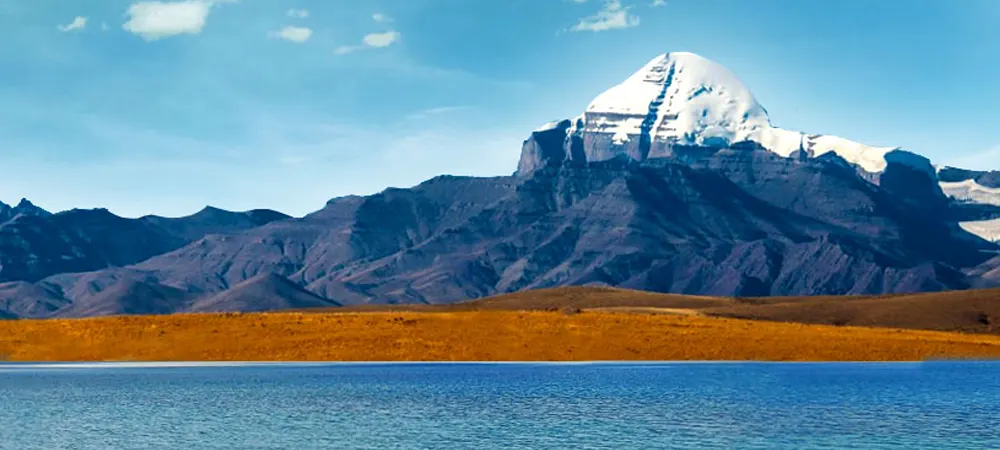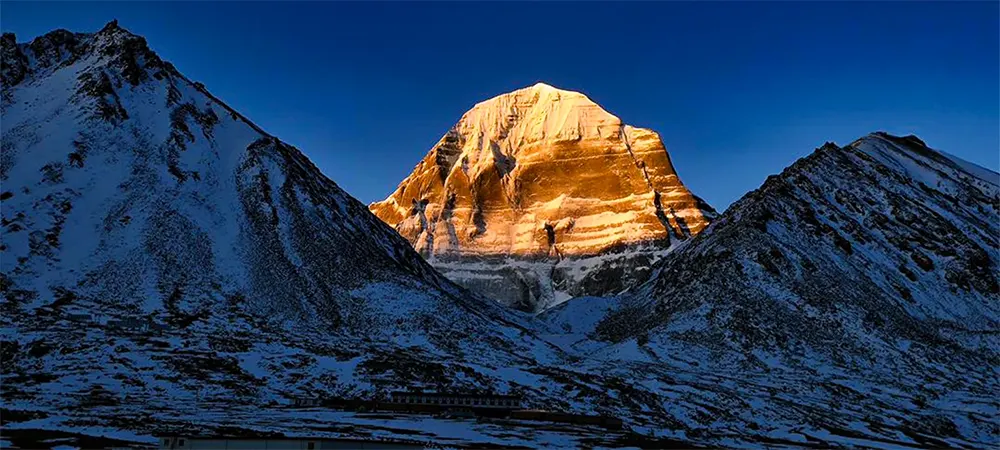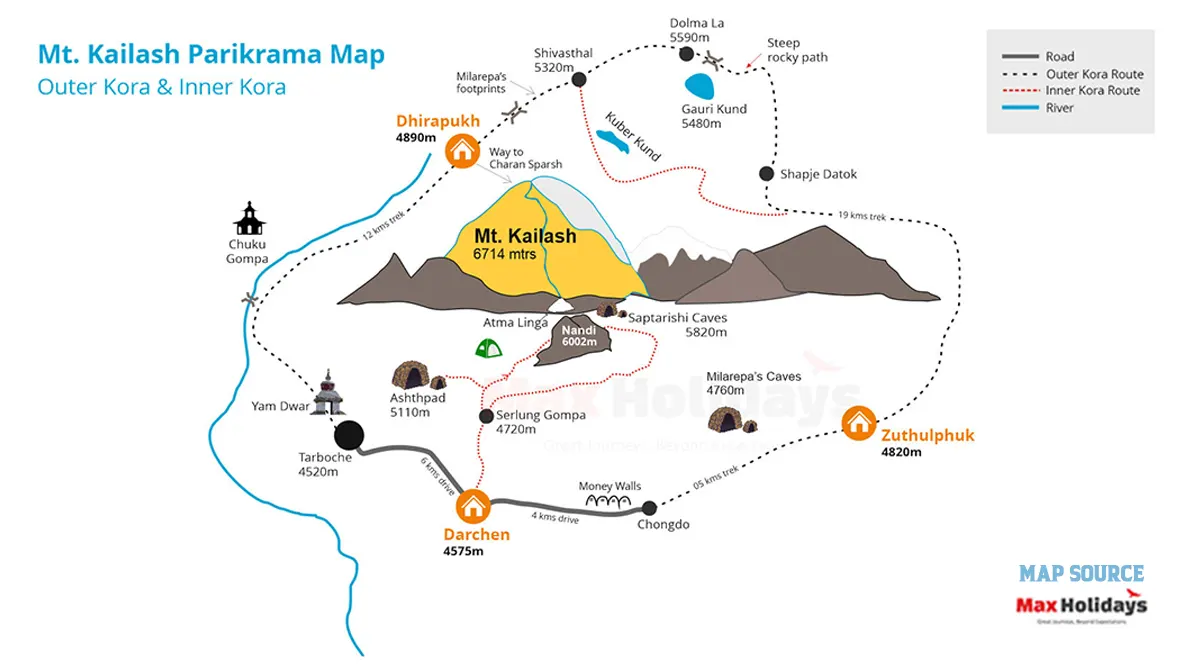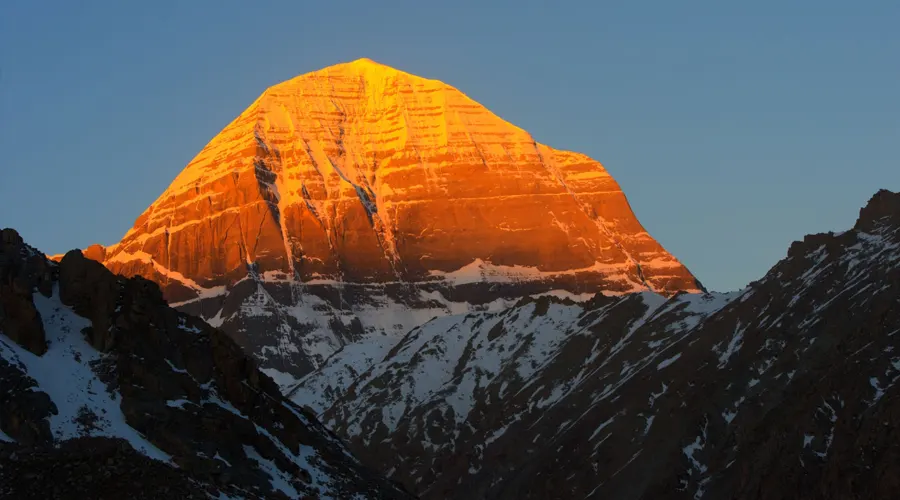Kailash Mansarovar Yatra – A Sacred Journey to the Abode of Lord Shiva
Situated in the far Western Himalayan ranges of the Tibetan Autonomous Region, the 6638-meter-talldiamond-shaped Mount Kailash (also Kailāsa in Hinduism& Gang Rinpoche in Tibetan) and the largest freshwater Lake Mansarovar (also Manas Sarovar in Hindi & MapamYumtso in Tibetan) are the source of divine energy and mental peace for mankind.
Mount Kailash and Lake Mansarovar are considered the most sacred places in the Hindu, Jain, Buddhist, and Bon religions. Every year,from April to October, many devotees and adventure seekers visit Kailash Mansarovar from all over the world.
Why is Kailash Mansarovar Yatra a Must-Do journey?
The Kailash Mansarovar Yatra is an adventurous and spiritual journey through iconic locations including Lake Mansarovar, Kailash Mountain, and the beautiful Gaurikund.
During your journey, you get to witness the beauty of Mount Kailash closely. It is considered a holy peak in Hinduism, Buddhism, Jainism, and the Bon religion. Hindus believe it to be the sacred abode of Lord Shiva, where he resides with Goddess Parvati.
Mount Kailash is considered too sacred to be scaled, however, you get the special chance to touch its holy surface during the Parikrama.
Embrace the beauty of the pristine Mansarovar lake, a high-altitude glacial lake with crystal clear blue water.

Gaurikund is another iconic location during your journey; it is an amazing emerald lake that sits beautifully amid the rugged terrains and towering mountains.
The journey involves crossing some of the most thrilling high-altitude passes, including the Dolma La and Mayum La, that offer amazing views.
The Kailash Mansarovar Yatra takes pilgrims through the breathtaking terrains of Nepal and Tibet. From the lush green valleys and charming villages of Nepal to the rugged, vast landscapes of Tibet, the journey is a visual delight.
One of the most magical aspects of the journey is witnessing the changing colors of Mount Kailash. During different times of the day, the peak appears white, golden, and even reddish, creating an otherworldly spectacle.
Kailash Mansarovar Yatra- A Journey of Faith and Stunning Beauty
The Kailash Mansarovar Yatra is a once-in-a-lifetime spiritual journey that takes you through the stunning landscapes of Nepal and Tibet, combining both trekking and driving. Along the way, you’ll witness crystal-clear lakes, rugged mountains, and vast open skies, leading you closer to the majestic Mount Kailash. This sacred pilgrimage is deeply rooted in mythology and spiritual significance, making it a dream destination for many.

One of the most special moments of this journey is “Charan Sparsh”, the chance to touch the base of Mount Kailash, a rare and blessed opportunity, as the mountain is considered too sacred to be climbed. While many people admire its beauty from afar, pilgrims on this yatra get to experience its divine presence up close.
The trek is slightly challenging at the end, but the peaceful surroundings, crisp mountain air, and deep sense of devotion make it an unforgettable experience. Many travelers describe feeling a powerful spiritual energy that cleanses the soul and transforms their outlook on life. Along with being a pilgrimage, the Kailash Mansarovar Yatra is a journey of self-discovery, faith, and stunning natural beauty.
Along this stunning and sacred journey, you will cross the Nepal-China border, witnessing a remarkable shift in landscapes as you move between the two countries. Due to security concerns, your documents will be checked frequently at various points. As you travel from Kathmandu to the border, you will encounter a few security checkpoints by the Nepalese police and military.
The route passes through the Langtang National Park region, a protected area where strict regulations are enforced to ensure safety and conservation. Once you enter the Tibet region, the forces there will also verify the documents. These checkpoints, though frequent, are a necessary part of the journey.
Char Dham Yatra 2025: Complete Guide, Opening Dates & Registration Details
Kedarnath Yatra 2025 Registration
Kedarnath Yatra 2025 Opening Date: Plan Your Pilgrimage Now
Kedarnath Temple History
Amarnath Yatra 2025 Registration
Major attractions of the Kailash Mansarovar Yatra
- Pashupatinath temple: Pashupatinath is a famous Hindu temple in Kathmandu, which you can visit before beginning your journey to Kailash Mansarovar. Pashupatinath is dedicated to Lord Shiva and located at the banks of the hickey Bagmati river, which adds more beauty to the surreal surroundings of the temple. The temple is a beautiful architectural masterpiece and even a UNESCO World Heritage site. When you visit this temple, you can also perform the renowned Rudrabhishek ceremony to seek the blessings of Lord Shiva. It's believed that this ceremony is performed to remove obstacles, bring prosperity, and strengthen one’s connection with the divine.
- Mansarovar Lake: Mansarovar is a stunning blue lake surrounded by rugged mountains, creating a breathtaking sight. From the lakeside, you can see the peak of Mount Kailash rising above the surrounding hills, adding to the magical view. The lake’s crystal-clear waters beautifully reflect the divine presence of Kailash, making it a truly mesmerizing place. According to Hindu mythology, it is believed that taking a dip in its holy waters washes away sins and purifies the soul. The experience of simply being near Mansarovar is unforgettable, you can feel the cool mountain breeze, hear the gentle ripples of the water, and lose yourself in the vast, peaceful landscape. The sky above is often painted in shades of blue and orange, while the towering mountains around add to the lake’s mystical charm. Whether at sunrise or under a starry night sky, every moment here feels magical and deeply spiritual.
- Rakshas Tal: Rakshas Tal is another beautiful lake near Mansarovar, but it is believed to be the complete opposite of Mansarovar Lake. Unlike the fresh waters of Mansarovar, Rakshas Tal has highly saline water and does not support fish or other aquatic life. In many religions, touching its water is considered inauspicious, and the lake is believed to have negative energies. However, despite these beliefs, Rakshas Tal remains clean and peaceful, as it is rarely visited by people.
- Mount Kailash: Mount Kailash is considered a holy peak in many religions. Pilgrims from all over the world come here to complete the challenging Kailash Parikrama (circumambulation), a sacred journey believed to bring spiritual liberation and blessings. According to Hindu mythology, Mount Kailash is the axis of the universe, from where four great rivers, including the Indus, Brahmaputra, Sutlej, and Karnali, originate, giving life to vast regions of Asia. Beyond its deep spiritual significance, Mount Kailash is also a breathtaking natural wonder. Towering at an impressive height, its snow-covered peak glows under the sunlight, creating a spectacular sight against the clear blue sky. The rugged landscapes surrounding it are dotted with valleys, glaciers, and high mountain passes, offering some of the most pleasant views on Earth. Whether seen at sunrise, when the peak turns golden, or at night, under a star-lit sky, the beauty of Kailash is truly otherworldly.
- Dolma La: This pass is the most challenging part of the trek. The journey to the pass is steep and demanding, but reaching the top is a memorable experience. At the highest point, vibrant prayer flags flutter in the cold mountain wind, adding a touch of color to the rugged, snow-covered landscape. From here, you can take in breathtaking views of the surrounding peaks, deep valleys, and vast, open skies. The peaceful silence, broken only by the wind, makes the place feel almost otherworldly. Despite the difficulty, standing at Dolma La is a moment of pure awe, a place where nature’s raw beauty meets deep spiritual significance.
- Gaurikund: Located on the way from Dolma Pass, you will get a glimpse of Gauri Kund. Gauri Kund is a sacred lake along the Kailash Mansarovar Yatra. According to legend, Goddess Parvati bathed in this pond, and it is believed to be the place where Lord Ganesha was created. The emerald-green waters of Gauri Kund shine beautifully against the backdrop of snow-covered peaks. Surrounded by rocky cliffs and icy landscapes, the lake has a peaceful and mystical charm. The reflection of the towering mountains in its still waters creates a breathtaking sight that will surely leave you mesmerized. The crisp mountain air, the silence of the high-altitude wilderness, and the sheer beauty of this hidden gem make it a truly divine and unforgettable experience.
Mt. Kailash and Lake Manasarovar
Mt. Kailash is known to be the heavenly abode of Lord Shiva and is also considered to be a pilgrimage destination packed with some of the most fascinating lessons of spirituality.
It is situated in the Kailash Range (Gangdise Mountains) of the Transhimalaya and carries a highly religious importance too. On the other hand, considered as the most sacred lake in Tibet, Lake Manasarovar is majorly prominent as the world's highest freshwater lake, and millions of ardent devotees come from the nooks and corners of this world to experience its unique beauty lying at an elevation of 4,590 m.
Weather conditions in the TAR Region
TAR (Tibet Autonomous Region) is considered to be a region with a cold climate, making the people living there wear varied layers of clothes. It is known to have a harsh climate, and during the wintertime, the temperature here goes below -30°F, and on the other hand, it goes above 100°F during the summertime.
The Tibet Autonomous Region is a highly dry spot with a hot and cold climate reaching the extreme, accompanied by the thin air as well as the sunshine from the high elevation.
Location, People, and Language
Mount Kailash lies in the Tibet Autonomous Region in China, and the people living here are the Tibetans, covering more than 90% of the population, Chinese, and also the Nepalis.
Talking about the official language used as a communicator in the Tibet Autonomous Region, it is none other than the Standard Tibetan, vocalized in the form of the Tibetic languages. Apart from this, one may also witness the people speaking Chinese as well as the Nepalese here, along with the majority of the population being fluent in speaking as well as understanding English.
Routes to visit Kailash Manasarovar
Millions of pilgrims intend to visit the Kailash Manasarovar,which is known to be accessible from various points. One can be a participant in the Kailash journey inan abundance of ways. The most favored and also the 'less complex' routes for reaching here are Kathmandu in Nepal, Simikot in Nepal, and Lhasa in Tibet.

Apart from this, the Indian Ministry of External Affairs (MEA) has figured out two routes for experiencing the divine Kailash Manasarovar Yatra, which are none other than the route through Lipulekh Pass (Uttarakhand) and the route through Nathu La Pass (Sikkim).
Currency
'Renmibi' or the 'Yuan' is considered to be the official currency of Tibet same as the one followed in China. The currency is available in the form of banknotes as well as coins. The banknotes are prevalent in the denominations of 100, 5, 50, 20, 2, and 1 yuan; 5, 2, and 1 Jiao; and 10, 2, 5, and 1 fen.
Whereas, the coins are prominent in the denominations of 1 yuan, 5, 2, and 1 Jiao; and 5,2, and 1 fen. The Central Bank of China branch consists of a good number of ATMs, which can presently be used for the withdrawal of the Renminbi currency. Thus, the visitors can easily be facilitated with the Renminbi currency while being present here.
Dos and Don'ts for Kailash Yatra
Kailash Manasarovar Yatra is a highly religious journey and is also considered to be a harder one. But its result is simply priceless. While experiencing the spiritual journey to Mt. Kailash, the devotees have always claimed the attainment of inner serenity as well as a sense of relief. In case you are striving to indulge in the same, there are many strict guidelines prominent and an array of dos and don'ts which you need to follow while journeying to have glimpses of the heavenly abode, i.e., the Mount Kailash.
Who Can Participate
Age Requirements:
- Minimum 18 years
- First-timers are welcome, though prior trekking experience is preferred. Good fitness is a must.
Fitness Criteria:
- The Trekker should have sufficient stamina to cover 5 km of distance by jogging in 30 minutes without stress or 10 km of distance in 70 minutes without stress
- If the trekker prefers cycling, they should be able to cycle 18 km of distance in 50 minutes.
- Preparation Chart view download
- If the trekker wants to carry a backpack, then he/she should be able to carry a 10-12 kg backpack. If opt Off-load option then the trekker should be able to carry a 3-5 kg backpack.
- If a trekker's BMI is more or less than the normal range (18-27), please consult our Trek Coordinator before booking.


Comments (0)